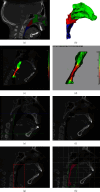Adults with Treacher Collins Syndrome Share Comparable 3D Upper Airway Dimensions with Nonsyndromic Individuals
- PMID: 38962724
- PMCID: PMC11221962
- DOI: 10.1155/2024/6545790
Adults with Treacher Collins Syndrome Share Comparable 3D Upper Airway Dimensions with Nonsyndromic Individuals
Abstract
Purpose: Sleep apnea symptoms, such as snoring and daytime somnolence, are commonly observed in individuals with Treacher Collins Syndrome (TCS) and may be related to airway obstruction due to micro- and retro-gnathia. This study aims to three-dimensionally evaluate the upper airway using cone-beam computed tomography (CBCT) exams of adolescents (TCS-ADOL) and adults (TCS-ADUL) with TCS compared to a nonsyndromic group (CON).
Materials and methods: Twenty-six CBCT exams were divided into three groups: TCS-ADOL (n = 7) (13.14 ± 1.67 years): CBCT exams of TCS adolescents; TCS-ADUL (n = 10) (21.80 ± 4.39 years): CBCT exams of TCS adults; and CON (n = 9) (25.33 ± 8.57 years): CBCT exams of adult nonsyndromic individuals with Class II skeletal pattern. The variables analyzed were (1) total upper airway volume; (2) nasal cavity volume; (3) total pharyngeal volume; (4) nasopharyngeal volume; (5) oropharyngeal volume; (6) pharyngeal minimal cross-sectional area; (7) pharyngeal length; and (8) pharyngeal depth. Scans were analyzed by two examiners, and intra- and inter-rater agreement was calculated. A p-value of ≤0.05 was considered significant.
Results: Although not statistically significant, the TCS-ADUL group showed decreased airway volume and minimal cross-sectional areas compared to the CON group. There were also significant differences between TCS-ADOL and TCS-ADUL, with significantly lower airway volumes in the TCS-ADOL group. Strong positive correlations were found between certain airway measurements in the TCS-ADOL group, which were not observed in adults.
Conclusions: The upper airways of adults with TCS are dimensionally similar to those of nonsyndromic individuals, despite absolute value reductions found in the syndromic group. The reduced airway in the adolescent population suggests significant potential for growth, mainly in pharyngeal dimensions.
Copyright © 2024 Renan Jhordan Mettelziefen dos Inocentes et al.
Conflict of interest statement
The authors declare that they have no financial interests and conflicts of interest.
Figures





Similar articles
-
Three-Dimensional Upper Airway Assessment in Treacher Collins Syndrome.Cleft Palate Craniofac J. 2020 Mar;57(3):371-377. doi: 10.1177/1055665619885555. Epub 2019 Dec 5. Cleft Palate Craniofac J. 2020. PMID: 31801369
-
[Three-dimensional measurement analysis of midface morphology in Treacher Collins syndromes].Zhongguo Xiu Fu Chong Jian Wai Ke Za Zhi. 2021 Jan 15;35(1):86-94. doi: 10.7507/1002-1892.202009004. Zhongguo Xiu Fu Chong Jian Wai Ke Za Zhi. 2021. PMID: 33448205 Free PMC article. Chinese.
-
Assessing the Accuracy of Lateral Cephalogram in Quantifying Three-Dimensional Pharyngeal Airway Morphology Compared to Cone-Beam Computed Tomography.Cureus. 2024 Mar 31;16(3):e57301. doi: 10.7759/cureus.57301. eCollection 2024 Mar. Cureus. 2024. PMID: 38690459 Free PMC article.
-
Comparative Assessment of Pharyngeal Airway Dimensions in Skeletal Class I, II, and III Emirati Subjects: A Cone Beam Computed Tomography Study.Dent J (Basel). 2024 Sep 25;12(10):301. doi: 10.3390/dj12100301. Dent J (Basel). 2024. PMID: 39452429 Free PMC article.
-
Reliability of upper pharyngeal airway assessment using dental CBCT: a systematic review.Eur J Orthod. 2017 Oct 1;39(5):489-496. doi: 10.1093/ejo/cjw079. Eur J Orthod. 2017. PMID: 27999121
References
-
- Katsanis S. H., Jabs E. W. GeneReviews . Seattle: University of Washington; 2004. Treacher Collins syndrome. - PubMed
LinkOut - more resources
Full Text Sources

